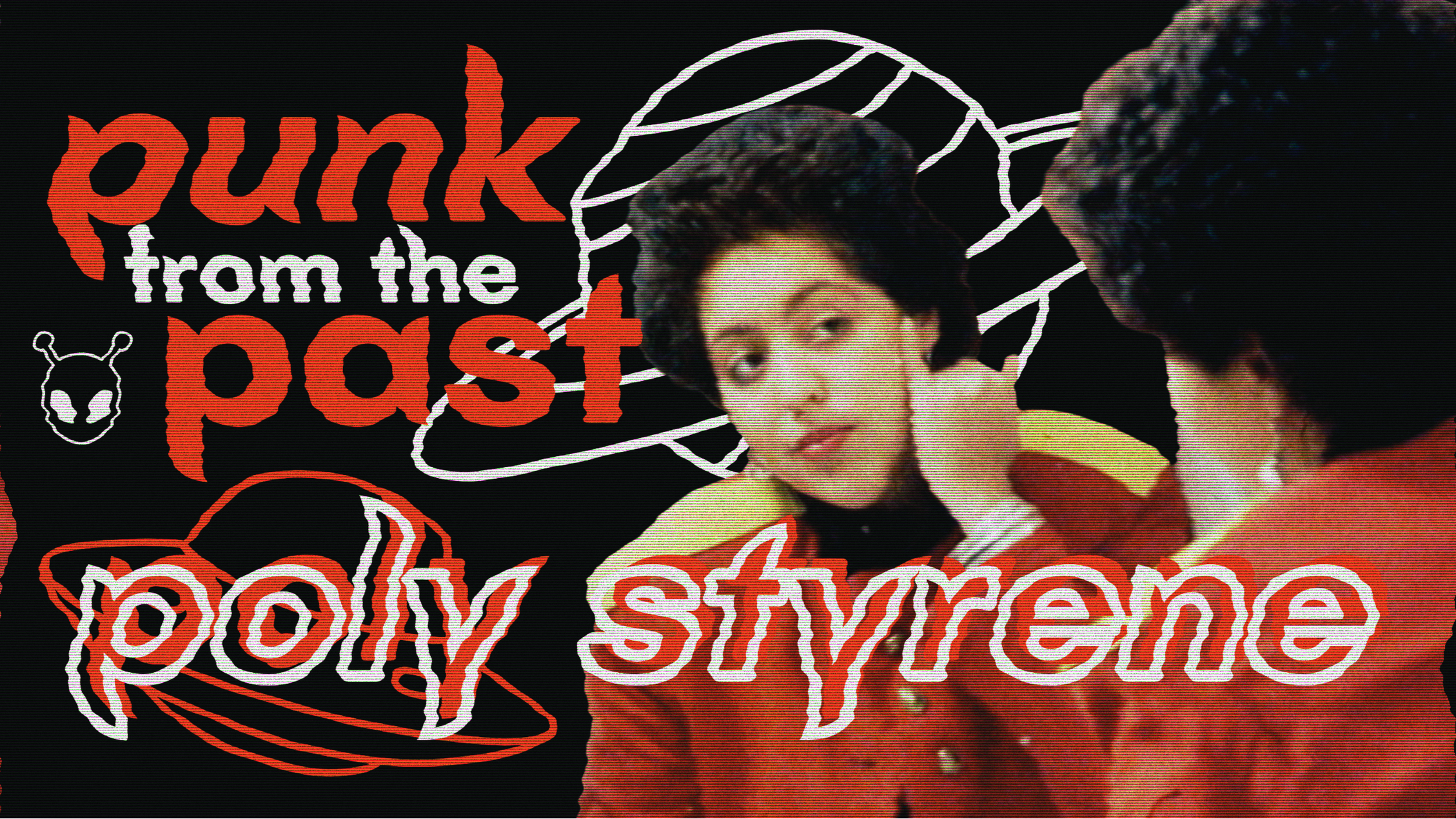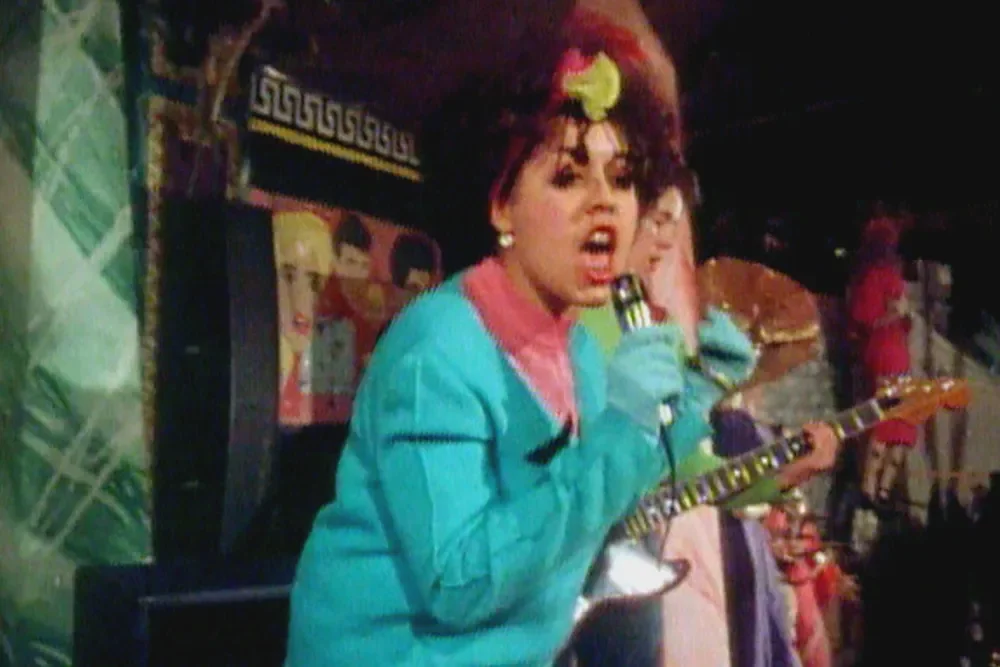Punk from the Past: Poly Styrene
"When you're mixed race, it's hard not to feel like an outsider looking in half the time. You often feel like you don't belong anywhere. But that can be liberating, too."
-- Celeste Bell
Whilst researching this piece on Poly Styrene, the frontwoman of the 1970s British punk band X-Ray Spex, I developed a sort of parasocial kinship for both Poly (a.k.a. Marian Elliot) and her daughter, Celeste. I'm in no way the first to do this. Celeste's poignant documentary about her mum's life -- Poly Styrene: I Am a Cliché -- takes anecdotes from rock icons inspired by the late, great, and complicated Styrene herself. Kathleen Hanna, Pauline Black, Neneh Cherry; all recognised Poly's game-changing contributions to a genre dominated by skinny angry white guys.
"I think my mum got to the point where she said, 'I'm gonna carve out a place in the world for myself.' And you know what? She did."
— Celeste Bell
In carving out her place, Poly sacrificed her health. The pressure of fame surrounded her with a plastic cave of recognition, objectification, and commodification. Poly Styrene was left with figurative bite marks where parts of her innocence died as she clung onto her hard-won sense of self. Her identity.
Poly Styrene photographed by Ian Dickinson
Poly's dissection of her mixed ethnicity began early, as it does for many of us with multi-racial backgrounds. A British Somali girl from South London, her experience of aggressive racism was not unlike my mum's (a British South African girl in Essex). Poly's poem "Half-Caste", written in one of her early diaries, explores this liminality:
Black is beautiful
White is alright
Your half caste girl
You wanna fight?
Black girl carries a flick knife
Will she cut me up
for being half white?
The National Front are after me
I'm infiltrating, can't you see?
In her documentary I Am a Cliché, Celeste describes herself as "quarter-caste." This is my mix too. The thing with mixed race identity is that you can, depending on your complexion, pass as white, particularly so if your mixed heritage dates back to your grandparents. But there's an inherent sense of longing, of confusion, of curiosity. As Celeste puts it, you feel like an outsider looking in. If you haven't had the opportunity to learn about that part of your ethnicity, there remains a question mark over where you're 'from'. What box do I tick on a form? Am I brown? Or am I just white? If I'm just white, then why do I look the way I do? Why does my mum look the way she does?
Safe to say, it's not that black-and-white. But this search for identity was ever-present in Poly's writing, whether it be her journals or her music with X-Ray Spex:
When you look in the mirror
Do you see yourself?
Do you see yourself
On the T.V. screen?
Do you see yourself in the magazine?
When you see yourself
Does it make you scream?
For me, and for other artists, Poly was their first time seeing a mixed-race girl yell into a microphone. In I Am a Cliché, Pauline Black, frontwoman of the two-tone ska band The Selecter, says:
Obviously, identity meant something to her because of the song. It was not only talking about women within rock music; it was also talking about how many black women did you see on the front covers of fashion magazines? It was, in a way, I guess, up to us to carve out our own identities.
In the current era of rampant consumer-capitalism, the line between trailblazer and token grows ever-thinner. It's easy to package a person, especially a woman, into the role of "first __ to do __" and forget the circumstances that made that an achievement in the first place. In the 1970s, when women's liberation became a hot topic of conversation, interviewers attempted to box Poly into a feminist gimmick. But Poly never set her sights on one particular form of discrimination. She described the band's most well-known song, "Oh Bondage! Up Yours!" as a battle cry against all types of oppression. In doing so, Poly may have accidentally written a triple jeopardy anthem; the theme tune for intersectionality.
It's almost fitting that Poly fell apart in America. After a successful residency at London nightclub The Roxy (host to iconic artists such as Billy Idol and Generation X, The Buzzcocks, and Siouxsie and the Banshees), X-Ray Spex flew to New York to perform at the famous CBGB. Spex bassist Paul Dean describes how on their first night he saw "Paul Weller, The Jam, Debbie Harry sitting in the front row with a hat on."
Styrene got over it all very quickly. Her sister, Hazel Emmons, explained how "she didn't like that environment, she didn't like Top of the Pops, she didn't like mixing round all those kinds of people, she felt they were very superficial, and very not genuine." Poly wrote about her disdain for the vapid plasticity around her. The one and only X-Ray Spex album Germ Free Adolescents sees the band members on the cover, looking for a way out of their cramped test tubes, dressed in neon clothes reminiscent of the 20th century space age. A visual depiction of the trappings of consumerism.
As intersectionality today becomes institutionalised and bottled up into a corporate product, the claustrophobia Poly felt as she became a commodity is as obvious as ever.
The seemingly innocuous, inarticulate youth who ‘doesn’t know no history, threw the past away’, reluctantly assisting you at the self-service checkout at your local supermarket, might just be waiting to explode, destroying, in an orgy of nihilistic rage, the fake world of which they are as much a product of as you.
— Celeste Bell
This loss of a personal sense of identity combined with the constant smoke being blown up her ass exhausted Poly. Mixed with a bad night out and a puff of something that thoroughly disagreed with her, her mental health began to rapidly deteriorate. The darker thoughts and experiences raging in Poly's mind showered her songwriting:
When you look in the mirror
Do you smash it quick?
Do you take the glass
And slash your wrists?
Did you do it for fame?
Did you do it in a fit?
Did you do it before
You read about it?
Poly's sensitivity was often dismissed by the masculine punks around her. There was a period when she lived nearby John Lydon (known more widely as Johnny Rotten, lead vocalist of the Sex Pistols) and would often visit his home out of the blue. Film director and DJ Don Letts describes in I Am a Cliché a time when Poly came to Lydon's home when himself and a group of other guys were there, "shooting the breeze and being typical lads and sort of ignoring her." He goes on to recount her radical method of demanding their attention:
At some point, during the conversation, during the night, she got up and went into the bathroom. And no one thought anything of it. And then -- I guess we were talking for a while and not realised that she'd probably been gone for like, half an hour. And we heard the bathroom door open, and we looked up, and she started to walk down the stairs, and she'd cut all her hair off. I'll be honest with you; we were totally insensitive to the moment.
The next day, X-Ray Spex were to perform at Rock Against Racism in Victoria Park. She arrived onstage with a green headscarf wrapped around her head in front of a crowd of 100,000 people. Despite the band's manager insisting she keep the scarf on her head for the duration of the performance she slowly, slowly, slowly began to unwrap it, revealing her freshly shaved buzzcut to the ginormous crowd. Paul Dean said that the rest of the band buzzed their hair in solidarity. The shaving was meaningful to Poly: "she said she didn't want to be a sex symbol, and if she thought she was turning into one, she'd shave her hair off, and that's what she did," Paul reveals in I Am a Cliché.
The head shaving epitomised her desperation to maintain control over her image -- her identity. Despite the band's attempts to keep going, Poly's mental health continued to fall to the wayside. She was soon unable to continue performing. She was sectioned at The Maudsley, a psychiatric hospital in London.
In "Art-I-Ficial", Poly sings:
I know I'm artificial
But don't put the blame on me
I was reared with appliances
In a consumer society
When I put on my make-up
The pretty little mask not me
That's the way a girl should be.
Initially misdiagnosed with schizophrenia due to her hallucinations, Poly was eventually diagnosed with acute bipolar disorder.
Poly Styrene with Sid Vicious, Nancy Spungeon, and Johnny Rotten
Years passed and Poly would go on to have a whirlwind romance with Adrian Bell, who she would go on to marry and have a child with, Celeste Bell, at the age of 24. Motherhood was a challenge for her. As she adjusted to a more conventional life, she still searched for a deeper meaning. She was no longer the frontwoman of X-Ray Spex. She wanted to become Marian again. In her journey to reconnect with herself, she joined the Hare Krishna movement. She and her family moved into the communal temple and were christened with new names by their guru, Bhagavan: Marian as Maharani, Celeste as Radha Shakti.
But the Hare Krishna could not provide the support Marian needed with her health. Her episodes continued and eventually she moved the family out of the temple. Celeste takes on a tone of sadness when reminiscing upon the departure; the friends she had made at the Hare Krishna school were suddenly taken away from her and her mother left her isolated through her neglect.
I was eight years old when I went to live with my grandmother, who was eventually granted custody of me after a long and bitter court case. It was clear mum had neglected me. I was three and a half stone when I was removed from her care. I needed years of therapy. To say that I was an angry kid would be an understatement. I told the court I wanted to live with my nan. The ultimate betrayal as far as my mother was concerned. Our relationship was pretty rough for a while. Lots of shouting, slammed doors, and angry tears. She pushed me down the stairs once and I never let her forget it. She wasn't in her right mind of course, but I blamed her for ever bringing me into this world.
Celeste Bell and her mother, Marian Elliot/Poly Styrene
When Celeste reached adulthood, she moved to Madrid and created her own life. Marion took up a slower pace of life in Hastings. After being estranged, the distance between the two provided opportunity for reflection, accountability, and forgiveness. Reconnecting with a parent after abuse is not a straightforward journey and not everyone will have the privilege of being able to do it. But before Marian's death from breast cancer in 2011, the two had the chance to reconnect and make music together.
Celeste even joined her mother on stage at the final X-Ray Spex gig at the Roundhouse in 2008, singing alongside her to "Oh Bondage! Up Yours!"
In Celeste's article about her mother and I Am a Cliché for Fred Perry, a quote from Kathleen Hanna -- frontwoman of Bikini Kill, Le Tigre, and pioneer of the Riot Grrrl movement -- states that "if [Poly's] work wasn't there, I am not positive Riot Grrrl would exist." Riot Grrrl was a movement that leaves a complicated legacy, but one which many (including myself) continue to be influenced by. It lacked intersectionality, a criticism which Hanna herself willingly takes. It became yet another victim to consumerism, rebranded as the far more palatable "girl power" slogan of the Spice Girls. It was tokenised, like Marian/Poly was herself, and lost its true identity.
But Celeste reclaimed her mother's memory through her thoughtful filmmaking. I Am a Cliché provides a truly intersectional lens, one uninhibited by institutionalisation, one that acknowledges both Marian, her mother, and Poly, the performer. Not a token for the taking, not a product for public consumption, but an artist trying to make sense of herself and the disillusioned society around her. An uninhibited trailblazer who was a patchwork of problems and punk idolatry, but most notably, a person.







